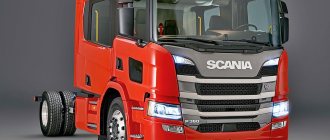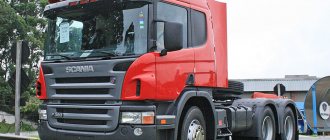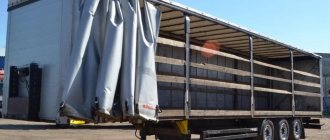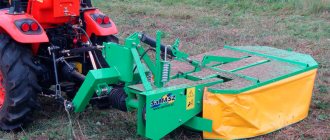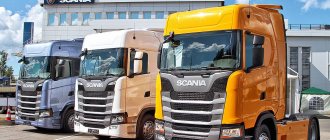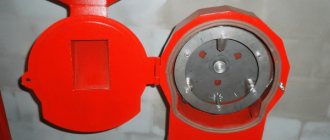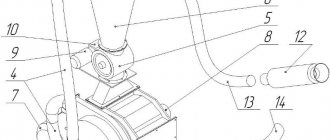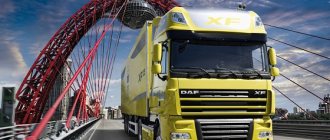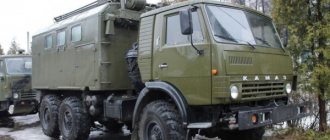May 15, 2022 Category: Interesting news.
We consider the features of modifications of Scania trucks.
Unlike Europeans with their love for special versions of tractors - with an ordered engine, transmission, chassis, cab and options, Russian dealers offer mainly standard equipment for trucks. The most common option is two-axle tractors with a 4*2 wheel formula. There are 6*4 variants, but three-axle 6*6 all-wheel drive ones are rare.
In total, there are over 30 standard versions of Scania truck tractors.
Their classification is based on the type of cabin. The simplest one, type P, can be installed not only on a truck tractor, but also on a delivery truck and a dump truck. The option that is medium in size and cabin trim is designated by the letter G. The common flagship option is R.
In addition, the model index indicates the cabin roof (N - normal, H - high), engine power and chassis parameters.
The most common Scania trucks in Russia are P, G, R.
Series P: carriers for wholesale and retail trade
The P series includes distribution trucks designed for everyday work in the trade. Well-thought-out features of the interior and exterior help to individually select a verified package in accordance with the needs of each specific business.
Their diesel engines have been specially developed and adapted for urban use: in delivery trucks, straddle loaders and airfield service vehicles.
The P series machines are characterized by excellent visibility and handling, a high level of safety and a sense of control, convenient access to the cabin, and the ability to easily and quickly get in and out. This is facilitated by large, ergonomically inclined steps, large comfortable handrails, and a low floor level.
The cabins are compact, double. In addition to a day cab with additional space behind the seats, a short cab is also available to reduce the overall length of the vehicle. As an option, you can order the installation of undivided seats in the cabin for two passengers, thereby turning it into a three-seater. There is also a cab option with a berth.
Cabin height: 2920 mm without air deflector - in a simple short cabin; 2920 or 3260 mm without air deflector - in the day cabin with additional space behind the seats; 2920, 3260 mm or 3520 mm without air deflector - in a long cabin with a berth (it can be 80 cm or 1 meter wide)
Air suspension improves the efficiency of cargo transportation, helping to carry out loading and unloading operations faster. The chassis height is easily adjustable for convenient loading and unloading.
The P series offers vehicles with different wheelbases, as well as the ability to select the optimal axle arrangement for bodies of a certain length. As a result, optimal weight distribution and an extremely tight turning radius in tight urban spaces are guaranteed.
Engines – 7, 9 and 13 liters; There are both diesel and gas- and ethanol-powered ones.
Power range:
- 7 l – 220 l. s., 1000 Nm; 250 l. s., 1100 Nm; 280 l. s.,1200 Nm;
- 9 l – 280 l. s.,1350 Nm; 320 l. s., 1600 Nm; 340 l. s., 1600 Nm; 360 l. s., 1700 Nm;
- 13 l – 370 l. s., 1900 Nm; 410 l. With. , 2150 Nm; 450 l. s., 2350 Nm; 500 l. s., 2550 Nm.
A wide range of gearboxes can be adapted for any type of cargo transportation. To facilitate control, 8-speed (with range) and 12-speed (with divider and range) gearboxes can be equipped with Scania Opticruise and Scania Retarder systems.
The Scania rear axle range features robust, weight-optimized design and a wide range of final drives and ratios to suit your needs. All final drives are offered with differential locking. The P series includes cars with both a single rear drive axle and double axles (double rear drive axle).
THE TRUCK STARTS WITH THE CAB
According to some estimates, the cab accounts for up to a third of all costs when creating a new truck. The new Scania is truly completely new: from the frame to the filling.
The angle of inclination of the aerodynamic fairing can be adjusted by yourself
I can't say that she amazed me. Quite the contrary, my colleagues and I were expecting something more. However, over time, its perception settled in my mind, and no more questions about the design arose. In general, the design is fresh and, importantly, recognizable.
The new generation of cabs was developed taking into account four priority areas: driver working conditions, economical driving, optimal use of interior space, maximum safety and reliability.
Within the framework of the modular system professed by Scania, we can talk about at least 24 types of cabs. This will allow Scania to produce different cabs depending on customer needs.
The chassis layout is very tight
The cab frame was developed by Scania employees in close cooperation with Porsche Engineering. In terms of assembly, the new cabs differ in every way from the existing Scania lines, but at the same time their positive characteristics are preserved and enhanced.
High-strength steels are used as materials. Frame elements are made using both traditional and innovative technologies. They are connected to each other using welding, including laser. This creates a high-strength load-bearing structure.
The exterior design focuses on aerodynamics and, accordingly, fuel consumption. All front, side and even bottom surfaces are optimized for minimal air resistance. This was taken into account even when developing wipers, rear-view mirrors and optics. As an example, a non-standard sun visor was used. Both the air deflectors and the side fairings do not stand out from the general appearance, and their design is thought out as carefully as that of other parts. As a result, the total fuel economy from all innovations is achieved at 5%.
High beam - a “trick” from Scania
In all cabs in the new range, the driver's position is 65mm closer to the windscreen and 20mm closer to the side wall compared to the current generation cabs. This is done primarily to increase safety and visibility from the driver's seat, as well as to increase interior space (in particular for adjusting the bed and seat).
The dashboard is lowered slightly compared to previous models, which improves visibility in front of the truck. Particular attention was paid to ensuring that each driver had enough knee and leg room, even if they were wearing warm, thick clothing and large boots. The redesigned instrument panel also makes it easier to move around inside the cabin when the vehicle is parked. As an option, even a steering wheel with a bevel at the bottom is offered. Either as a joke or seriously - it will be more convenient for German drivers who have a fair amount of belly.
There are even more options for storage space, with a special emphasis on volume and accessibility. The cabin layout is carefully thought out and space is used efficiently. Depending on the cabin option, the chosen bed and other specific needs, you can choose a variety of storage containers, hooks and nets. There is a particularly wide selection when it comes to beds. Lower beds, like upper beds, have different designs and functionality depending on specific wishes and comfort requirements. Thus, in the S-type cabin you can install two beds with a width of 80 cm (the lower one can be expanded to 100 cm). They all have new mattresses.
New cabin - new interior. Even more pathetic
An additional option is a passenger seat that can swivel and recline for greater ergonomics and comfort in the cabin. There are a variety of interior lighting options available, allowing users to dim the lights and change the ambiance. Lightproof curtains have also been improved: they are made from new material and have become easier to use. The interior sun visors can be lowered individually and are easily adjusted on the go thanks to a convenient mechanism.
Scania has also developed completely new climate systems. Additional heaters can be installed in any cab, and a fully integrated air intercooling system can be ordered directly from the factory. It is integrated into a standard climate system so that heated or cooled air passes through special ducts and is controlled using a standard climate control panel. This ensures a more even climate, quieter operation of the system and uniform distribution of the desired temperature. Additional heaters are available with remote control and can also be used with alternative fuels.
When it comes to infotainment systems, it comes down to two well-integrated systems with 5- or 7-inch screens. Integrated steering wheel switches are standard, as is voice control via the roof microphone.
But the armrest on the door took some getting used to
The new generation of Scania cabs can be equipped with side airbags to provide protection in the event of a rollover. They are mounted directly into the cab roof, which has not previously been used in truck construction. Together with seat belts, side airbags create a reliable protective system in case of an accident.
At the same time, the design of the new cabin made significant changes to the model range. Firstly, the top-end cabin of the S series (Highline) with an almost flat floor (there is a small protrusion of 20 mm) appeared - CS20H. The maximum height of the living space is 207 cm.
Secondly, the R19T Topline version has disappeared from the range of cabs. From now on, the R series will be led by the CR20H variant with a maximum living space height of 181 cm. This is only 10 cm less than the previous generation in a comparable version.
Instrument panel with the same “self-criticism”
At first glance, it may seem that the new cabins have lost some useful volume, but this is only an apparent impression, since the length of the cabin has increased, and in the top version the engine tunnel has disappeared.
The new cabs are manufactured in a newly built plant in Oskarshamn, Sweden.
Series G: an intermediate option between urban delivery vehicles and long-distance highways
Russian carriers love Scania G series tractors. According to their reviews, such a machine lasts up to a million kilometers with minimal costs for spare parts, after which it can still be sold at a profit. This option is not as expensive as R or S, but much more comfortable on long journeys than P-series tractors. The vast majority of G-series cars registered in Russia, according to the analytical agency Autostat, are truck tractors.
Scania G-series tractors in our country can be found in the Griffin (simpler) and Streamline (more expensive) trim levels. The fleet of Scania G-series tractors is dominated by two-axle vehicles. For specific transportation conditions, some choose the three-axle 6x2 version with a sloth. A separate topic is the construction sector, which employs 6x4 tractors pulled by tipper semi-trailers.
The drive axle of conventional long-haul vehicles hauling trucks (it does not have hub gears, has a hypoid main gear and a differential lock) is suspended on semi-springs with 2 air springs. The front axle suspension is on leaf springs.
Engines: 9 and 13 liters; There are both diesel and gas- and ethanol-powered ones.
Power range:
- 9-liter: 280 hp, 1350 Nm; 320 hp, 1600 Nm; 340 hp, 1600 Nm; 360 hp, 1700 Nm.
- 13-liter: 370 l. s., 1900 Nm; 410 l. s., 2000 Nm; 410 l. s., 2150 Nm; 450 l. s., 2350 Nm; 500 l. s., 2550 Nm.
Gearboxes are also 8- and 12-speed, as in the previous R family.
R Series: long-range workhorses. But - premium class
Several generations of Scania R series tractors operate on Russian roads. During the 2013 restyling process, R-series trucks received the additional name Streamline, emphasizing the long-haul performance of these vehicles. For R-series tractors, the comfortable Streamline version became the only possible one, while G-series vehicles continued to be produced in a more modest Griffin version.
Scania R series cars are designed for chassis not only with six-cylinder in-line, but also with eight-cylinder V-shaped diesel engines. The high cabin - with a ceiling of 2230 mm - is only available on R-series machines.
A special feature of Scania diesel engines are separate cylinder heads and a wide unification of parts among units of different layouts (in-line and V-shaped) and displacement. The most popular engine option is the 13-(12.7-liter) in-line “six” of the DC13 family with a power setting of 400 or 440 hp. With.
The Scania R engine has “wet” cylinder liners, which simplifies overhauls, the timing drive is by gears on the flywheel side, and the valves are driven by rods from a camshaft located in the block. A special feature of the lubrication system for these engines is a centrifuge that cleans the oil parallel to the replaceable filters.
Reinforced frames of truck tractors have stronger side members - with a wall thickness of 9.5 mm instead of the usual 8 mm. Most of the tractors on the roads are on a 4x2 chassis with a wheelbase of 3700 mm in length. But to work with heavy semi-trailers, especially in regions with long and snowy winters, carriers also order three-axle vehicles with a 6x4 wheel arrangement. R-series tractors with a 6x2 wheel arrangement (with a “sloth”) are less common.
Based on its manual transmission, the company makes the Opti Cruise automatic transmission - it is included in the basic equipment of R-series tractors. The buyer has two options to choose from: a fully automatic transmission (there are only 2 pedals in the cabin), or a version with a clutch pedal.
Scania offers a wide range of drive axles with single final drives. We also offer a choice of wheel gearboxes in 2 versions, designed for different torques.
Dump trucks, tractors 6x6 Scania YAKUTIA KHABAROVSK MAGADAN BLAGOVESHCHENSK
Scania R730 tractor test - Scania R730 (2009). Comparison with MAN TGX 680
Scania takes the quality of the interior: the plastic is downright magnificent (no match for that of the new Actros!), the table is very hard, and in addition there are cozy details like night lamps on flexible legs.
If in MAN it is more convenient when parking, then in Scania it is more convenient when driving! The seating position is close to that of a car, and you find a comfortable position very quickly. The low-set mirrors do not interfere with the view, the panel “envelops” the driver... But the MAN is more “traditionally cargo-carrying”: the seating position is not so comfortable, and you have to get used to it; the seat, despite more developed lateral support, is not so cozy.
If without a truck Scania does not drive so confidently on a snowy road, then with it it is noticeably better than MAN! You don’t have to “catch” it with the steering wheel on the road, the car is less prone to skidding...
The difference is in the steering and suspension: Scania's steering is more accurate, but the steering wheel gets jolts from small irregularities. But MAN “swallows” them, but “eats” large potholes worse. And if the Scania’s steering wheel rim is thin, then the MAN’s is even too thick.
MAN is also noisier. If there is silence in Scania (except that the instrument panel creaks on bumps), then the MAN engine does not even whistle while driving, but howls, especially during gear changes.
Of course, both “automatic machines” operate imperceptibly, without even a hint of jolts when switching: the designers taught this to the electronics. But with MAN she strives to keep the tachometer needle below the “green zone” all the time and switch to a more economical, higher gear. This in itself is good, but on a snowy slope the car may lose speed and eventually stall!
In addition, the system switches gears up and down every now and then, looking for the most suitable one. I counted: on a snow-covered turning circle with a diameter of about fifty meters, the Manov gearbox “clicked” the steps eight (I repeat, eight!) times.
“The eighth - the seventh - oh, no, the eighth again, sorry, I was wrong, after all, the seventh, no, the ninth...” What are you talking about, dear? As a result, all the way we had to manually “push” the gears with the steering column lever (fortunately the system allows this), and on a long four-percent climb we had to completely switch to manual mode in order to “lock” the selected gear. Otherwise, in the middle of an ascent, the gearbox will easily switch to a higher gear and “land” the road train!
But Scanie’s “automatic” Opticruise is much more competent and intelligent. It’s as if he sees the road and knows what you need: he switches as rarely as possible and exactly at the speed required in a given situation, requiring almost no manual intervention. On the same lap, Opticruise changed gears only three times (twice down and when exiting the lap up), and on a long climb it not only allowed it to gain momentum, but also allowed it to accelerate the tractor. As a result, where on MAN I could hardly crawl up a hill at 50 km/h, Scania easily accelerated to 65 km/h!
And here's another thing. When, while driving a MAN in automatic mode, you “push” the gear manually, the system shows on the display that it has temporarily switched to manual mode. But if at this time you try to turn this manual mode “on permanently”, the box... goes into automatic mode again.
But with Scania everything is clear: if you drive in automatic mode, it is turned on even during manual manipulations with the gearbox. And as soon as you press the button on the end of the lever, “M” lights up on the display, manual, that is, manual mode.
Here it is, the difference between a purchased gearbox (let me remind you that MAN has ZF AS-Tronic) and a self-developed one! So the future lies with systems like Scania’s: with a slope sensor (that’s why the box “sees” the profile of the road) and “learning” (the system adapts to the driving style).
Fedor Lapshin
while moving, the MAN has to be held, and very tightly, like a horse that should not be allowed to feel the slack - especially on uneven surfaces. But Scania doesn’t just allow me to relax: it seems to guess my intentions! Before turning, you slightly release the gas, and the smart automatic transmission carefully slows down the car. The Scania cabin is also much quieter, and it has better visibility - unlike the MAN, where the A-pillars and huge mirrors get in the way.
Natalia Shevtsova, administrator of Autoreview
A MAN with a semi-trailer stands worse on the road - it is possible that it is due to different tires. In addition, Manov’s “automatic machine” was constantly trying to convince me that he was smarter, and I constantly had to correct him by “tucking” the gears. Click-click, click-click... I'm already tormented!
Not only was I struggling with the winter road here, but I was also struggling with the car: I practiced all the time, “oiling” the steering wheel and pulling it out of a skid. Now I understand why, in this weather, truck drivers in such “foreigners” can barely plod along: I’m in my Merc with a manual transmission, and I shift and go faster! And if I drive at the pace that MAN imposes on me, which customer will order me?
But Scania drives a semi-trailer much more confidently and engages gears the way I would engage them myself: it seems to understand me! It’s not surprising that when I was second in Scania, I was always “breathing down” MAN’s back, and when I was first, I “ran away” from him.
It’s also more comfortable for me to sit in Scania. Dmitry Silin, private truck driver, drives a Mercedes-Benz SK1838
Scania has a more pronounced mutual understanding between the car and the driver. Thanks to the “smart” gearbox, the tractor better understands what I want from it! Apparently, its automatic transmission is tuned specifically for this engine - and allows it to operate in a wide range of revolutions without having to change gears again (although in problem areas I still switched to manual control of the transmission - it’s more reliable). And the sound insulation of the Scania engine is clearly better.
powerful engines are good, say, when transporting heavy loads in mountainous areas, and overtaking with them can be completed quickly and safely.
Nikolay Panov, international truck driver, drives a DAF CF85
"Autoreview" 2012, No. 1
You can buy Scania R730 tractors from the official Scania dealer in the Far East - DV Scan LLC
- Detailed information about the Scania R730 tractor
- Test of the Scania R730 6×4 road train
Tags: R730, scania, scania dealer, skania, Scania reviews, Scania reviews, tractor sales Khabarovsk, truck tractor, scania, scania, Test tractors, truck tests, Khabarovsk truck sales
Series S: “the biggest league”, the dream of any truck driver
The S-series is the largest and most comfortable cabin, not only in Scania, but perhaps in all long-haul trucks in general. To get to this “top” cabin, you need to climb 4 steps, 2 of which are blocked by a door. Inside the cabin there is a completely flat floor; the internal height to the ceiling is 207 cm. The space is simply unrealistic, even just for the driver to reach the passenger is a real problem.
The ranges are truly enormous. You can sit just like in a car, with the driver's seat completely lowered to the floor and the steering wheel raised as much as possible - or vice versa. And the maximum height of the driver, which Scania experts expected, was 212 cm.
This is not just another “tail” on the old frame, but really a completely new cabin, with three roof heights.
Under the new cabin are new engines: a 13-liter inline six, the maximum power of which has been increased to 500 hp. s., and torque - up to 2,200 N.m, as well as a 16-liter V8 (the only one in the world that meets Euro 6 standards), covering a power range of 520–730 hp. With. In the new engines, it was decided to abandon the exhaust gas recirculation (EGR) system and achieve Euro 6 standards only by injecting synthetic urea AdBlue into the exhaust tract (using SCR technology).
To achieve this, serious work had to be done. The compression ratio was raised to 20.1:1 - this is a lot for a heavy-duty turbodiesel truck. The combustion chambers were optimized, eliminating the use of a variable geometry turbine, the air intercooler system was completely modernized, and the radiator area was increased.
The proprietary Scania OptiCruise automated transmission was not changed - it is already rightfully considered the best in this class. It is not for nothing that MAN has abandoned its own transmissions since 2022 in order to install OptiCruise on its trucks.
Scania S&R Series 2016. Next generation
Having attended the premiere of the latest generation Scania long-haul tractor, we were able to not only get acquainted with all the innovations that the truck is simply packed with, but also test it in real conditions on the roads of Sweden
Sergey Zhukov
Scania S & R Series 2016. Gross weight: over 16 tons. Start of sales: autumn 2016. Price in Western Europe: depending on configuration
Let's start with the fact that almost 21 years passed before Scania launched a new generation of trucks. To some this may seem like too long a period, but trucks change generations on average once every 20 years. The investment in development, the time required to prepare for production and fine-tuning the machines is too high. The Skanievites themselves talk about this.
The development of the new truck required 10 years and an investment of $2.35 billion. The prototypes traveled more than 10 million km along roads of different continents and climatic zones.
Now Scania's main task is to organize test drives of new cars for at least 40,000 existing and potential customers of the company. This will allow them to become more familiar with the entire Scania product range - from environmental enhancements to financing, insurance and maintenance options. And Scania itself can find out the backlash to its product.
“This is undoubtedly the largest investment in Scania's 125-year history,” says Henrik Henriksson, President and CEO of Scania. “My colleagues and I are immensely proud that we are now introducing products and services that will enable Scania to increase its market share and ensure its success over the next 10 years.”
So, what's new in the latest generation of Scania trucks?
THE TRUCK STARTS WITH THE CAB
According to some estimates, the cab accounts for up to a third of all costs when creating a new truck. The new Scania is truly completely new: from the frame to the filling.
The angle of inclination of the aerodynamic fairing can be adjusted by yourself
I can't say that she amazed me. Quite the contrary, my colleagues and I were expecting something more. However, over time, its perception settled in my mind, and no more questions about the design arose. In general, the design is fresh and, importantly, recognizable.
The new generation of cabs was developed taking into account four priority areas: driver working conditions, economical driving, optimal use of interior space, maximum safety and reliability.
Within the framework of the modular system professed by Scania, we can talk about at least 24 types of cabs. This will allow Scania to produce different cabs depending on customer needs.
The chassis layout is very tight
The cab frame was developed by Scania employees in close cooperation with Porsche Engineering. In terms of assembly, the new cabs differ in every way from the existing Scania lines, but at the same time their positive characteristics are preserved and enhanced.
High-strength steels are used as materials. Frame elements are made using both traditional and innovative technologies. They are connected to each other using welding, including laser. This creates a high-strength load-bearing structure.
The exterior design focuses on aerodynamics and, accordingly, fuel consumption. All front, side and even bottom surfaces are optimized for minimal air resistance. This was taken into account even when developing wipers, rear-view mirrors and optics. As an example, a non-standard sun visor was used. Both the air deflectors and the side fairings do not stand out from the general appearance, and their design is thought out as carefully as that of other parts. As a result, the total fuel economy from all innovations is achieved at 5%.
High beam - a “trick” from Scania
In all cabs in the new range, the driver's position is 65mm closer to the windscreen and 20mm closer to the side wall compared to the current generation cabs. This is done primarily to increase safety and visibility from the driver's seat, as well as to increase interior space (in particular for adjusting the bed and seat).
The dashboard is lowered slightly compared to previous models, which improves visibility in front of the truck. Particular attention was paid to ensuring that each driver had enough knee and leg room, even if they were wearing warm, thick clothing and large boots. The redesigned instrument panel also makes it easier to move around inside the cabin when the vehicle is parked. As an option, even a steering wheel with a bevel at the bottom is offered. Either as a joke or seriously - it will be more convenient for German drivers who have a fair amount of belly.
There are even more options for storage space, with a special emphasis on volume and accessibility. The cabin layout is carefully thought out and space is used efficiently. Depending on the cabin option, the chosen bed and other specific needs, you can choose a variety of storage containers, hooks and nets. There is a particularly wide selection when it comes to beds. Lower beds, like upper beds, have different designs and functionality depending on specific wishes and comfort requirements. Thus, in the S-type cabin you can install two beds with a width of 80 cm (the lower one can be expanded to 100 cm). They all have new mattresses.
New cabin - new interior. Even more pathetic
An additional option is a passenger seat that can swivel and recline for greater ergonomics and comfort in the cabin. There are a variety of interior lighting options available, allowing users to dim the lights and change the ambiance. Lightproof curtains have also been improved: they are made from new material and have become easier to use. The interior sun visors can be lowered individually and are easily adjusted on the go thanks to a convenient mechanism.
Scania has also developed completely new climate systems. Additional heaters can be installed in any cab, and a fully integrated air intercooling system can be ordered directly from the factory. It is integrated into a standard climate system so that heated or cooled air passes through special ducts and is controlled using a standard climate control panel. This ensures a more even climate, quieter operation of the system and uniform distribution of the desired temperature. Additional heaters are available with remote control and can also be used with alternative fuels.
When it comes to infotainment systems, it comes down to two well-integrated systems with 5- or 7-inch screens. Integrated steering wheel switches are standard, as is voice control via the roof microphone.
But the armrest on the door took some getting used to
The new generation of Scania cabs can be equipped with side airbags to provide protection in the event of a rollover. They are mounted directly into the cab roof, which has not previously been used in truck construction. Together with seat belts, side airbags create a reliable protective system in case of an accident.
At the same time, the design of the new cabin made significant changes to the model range. Firstly, the top-end cabin of the S series (Highline) with an almost flat floor (there is a small protrusion of 20 mm) appeared - CS20H. The maximum height of the living space is 207 cm.
Secondly, the R19T Topline version has disappeared from the range of cabs. From now on, the R series will be led by the CR20H variant with a maximum living space height of 181 cm. This is only 10 cm less than the previous generation in a comparable version.
Instrument panel with the same “self-criticism”
At first glance, it may seem that the new cabins have lost some useful volume, but this is only an apparent impression, since the length of the cabin has increased, and in the top version the engine tunnel has disappeared.
The new cabs are manufactured in a newly built plant in Oskarshamn, Sweden.
POWER LINE
In the new line of Scania trucks, all engines are Euro 6 standard. They are equipped with new control systems, and the power plants themselves are completely modernized. The complex of work carried out made it possible to further save fuel by an average of 3%. With the launch of the new truck, Scania is also introducing a new version of its 13-liter in-line engine with 500 hp. With. In addition, a new gearshift function is being introduced, which allows Scania Opticruise to change gears faster and provides a virtually constant flow of power.
From now on, all four 13-liter Scania engines (370, 410, 450 and 500 hp) led by a new 500 hp version. With. Equipped only with an SCR system for exhaust gas purification. The variable geometry turbine has disappeared. Other changes include upgraded combustion chambers and new injectors, which provide fuel savings of up to 0.2–0.5%.
As an option, the cabin can be raised using a servo drive. There is even a remote control panel
The introduction of an oil cooler thermostat allows you to control and optimize the temperature of the engine oil, preventing it from overheating. When the oil cooler thermostat is closed, oil flows directly into the lubrication system. When open, oil flows into the oil cooler. This innovation helps to further save up to 1% on fuel, as it helps maintain optimal oil temperature even at partial load and at low outside temperatures.
V-shaped “eights” have also undergone a number of improvements. In three power variants - 520, 580 and 730 hp. With. — they retain exhaust gas cleaning with the EGR system in addition to SCR.
Scania's adaptive cruise control system has also been upgraded: it can now operate at any speed, even to a stop. Of course, this is a significant help for drivers stuck in traffic jams.
New Scania provides easy access to key systems
Another big news is that Scania has introduced a countershaft brake as standard in Scania Opticruise automated gearboxes. The countershaft brake reduces countershaft rotation speed during upshifts. Gear changes occur faster and with less wear on the synchronizers compared to gearboxes without it. This is made possible by Scania's use of integrated solutions: the shafts synchronize with each other much faster and the next gear is engaged almost immediately. The intermediate shaft brake reduces gearshift times in Scania Opticruise by 45%.
Scania also has other innovations to reduce fuel consumption. For example, the ability to select a rear axle with an even “longer” gear ratio of 2.35 in situations where the carrier knows in advance the nature of the goods being transported and the routes to be followed (in particular, on flat terrain).
CHASSIS
The truck chassis has been redesigned. The front axle is shifted from the standard position 50 mm closer to the bumper (the front overhang is reduced). On truck tractors this led to an increase in the wheelbase by the same amount. This was done to reduce the degree of forward tilt of the truck in the event of sudden braking (also by shifting the center of gravity of the cab down) and to make the truck more comfortable to drive.
Now the basic equipment of trucks is equipped with 30-inch brake chambers for front axle disc brakes. This further ensures high braking performance regardless of whether braking is applied by the driver or by the AEB system. Real-world braking distances are affected by factors such as tire and road conditions, but all things being equal, the new truck has a braking distance that is 5% shorter.
The new in-line “six” is not much inferior to the V-shaped “eights”. But it has become structurally simpler and more reliable in operation due to the absence of complex units
The design of the frame, suspension and other chassis elements have not undergone any significant changes. In general, they do not seek good from good.
LIVE
The road trains chosen for testing were Scania S580 (4×2) with a 3-axle Schmitz Cargobull semi-trailer with a total coupling weight of 36 tons and a Scania R450 (6x2/2) with an unusual 4-axle tank from LAG with a total coupling weight of 40 tons.
In all this there was the following reason: to compare cabins with a flat floor and with a motor tunnel, the traction capabilities of the “six” and “eight”, while not forgetting that regional roads in Sweden are narrower than in Russia.
In essence, nothing special happened in my mind when I first saw the new Scania interior. Everything is thought out to the smallest detail, is within reach, and the number of adjustments is more than enough. No wonder the press release stated that any driver with a height of 150 to 200 cm will be able to find a comfortable driving position. The only thing that caused confusion was the location of the headlight mode switch on the door armrest.
But what, so to speak, pleasure did I experience driving a road train on a specially selected route of 38 km, most of which ran along a road replete with turns, descents and ascents! Everything was at a high level - the truck’s traction capabilities, its braking performance, including the operation of the engine brake, and even adaptive cruise control.
What can you say if so much time and money was spent on developing a car that claims to be in the top segment. At least not in vain.
WE DO NOT SELL TRUCKS, WE SELL SOLUTIONS
At one time, this phrase, expressed by a representative of the importer of a famous brand, sank into my soul. Today, a truck is just the tip of the iceberg in the work of a transport company, a tool. A lot depends on how you use it. That is why now all truck manufacturers offer various kinds of solutions to support it throughout its life. And Scania is no exception.
In recent years, the company has introduced a range of service and maintenance services in several markets. For example, using its own staff, Scania can take more or less responsibility for the customer's vehicle fleet. This may require the presence of a Scania expert at the customer's transport facility or, if necessary, at the customer's service workshop to plan and provide fleet maintenance. This may involve contracting out technical staff or setting up temporary workshops, for example in connection with large construction projects.
Almost a year ago, Scania began offering flexible plans as part of Scania Maintenance in all European markets. The new solution abandoned the traditional method of estimating mileage or the calendar method. Actual vehicle usage data is used to determine the need for maintenance according to a specific contract between Scania and the individual customer. As a result, oil change intervals can be up to 150,000 km under suitable operating conditions and when using quality Scania oil.
With the new generation of trucks, Scania is offering a number of new options related to vehicle communication capabilities based on the built-in Scania Communicator. Both carriers and drivers can access a new interface and services that are not tied to existing technological solutions.
And once again about the modular approach. Should a truck require repairs following an accident, Scania's modular design ensures that parts and components are much easier to access, minimizing the truck's time in the workshop. Another clear development goal was to significantly reduce downtime when minor external damage is repaired, regardless of whether a repair and maintenance contract has been concluded.
Production of the new trucks has already begun at the Scania plant in Södertälje. The initial focus will be on vehicles and services for long-haul freight transport. However, during the process of readjusting Scania's production facilities, additional versions will be constantly introduced.
The presentation of the line will continue after the premiere of new models in Europe. The entire process will culminate in the simultaneous launch of products in markets outside Europe.
The first truck will appear in Russia in December of this year - early next year, but in Euro-5 version. The car will come for certification. After completing all the formalities, approximately in the fall of 2017, sales will begin.
And finally. When this material comes out, everyone will already know that the next truck of the year was Scania Generation Next.
The editors recommend:
Why do piston rings stick and how to prevent it?
A traffic police officer searched my car: did he have the right to do so?
Russians may be left without foreign cars: Western automakers have stopped supplying cars to our country
A ship that was transporting cars to Russia was detained in France
Half of the car factories in Russia have closed
Discussion Cancel
Scania dump trucks
Scania trucks with tipper loading platforms work everywhere - from sand and gravel pits to construction sites. They are capable of any task that requires hard work: the company’s model range includes dump trucks of different “calibers”.
Their common features:
- comfortable working conditions for the driver;
- ergonomic workplace, with an exceptional viewing angle;
- excellent maneuverability;
- towing pin with a traction force of 35 tons - an emergency truck can be towed without unloading it;
- wide safety shield that is easy to remove or replace;
- approach angle 25° or more;
- a huge selection of specification options to classify a vehicle as an off-road truck;
- one-piece steel bumper;
- flexible landing step;
- comfortable handles and footrests;
- exhaust systems for all emission levels;
- Possibility of choosing an exhaust system with rear left, right or vertical placement;
- power take-off (PTO) – choice between engine and gearbox drive;
- Scania Retarder – adapted for use in the construction industry. Options for braking force parameters in the range of up to 4100 Nm. Increases braking efficiency and reduces brake wear. Optimized for use with Scania Opticruise.
All-wheel drive is available in 4x4, 6x6, and there is also a special version: 8x8. There is a choice of different standard, medium and high chassis options.
Rear suspension: 32 ton rear bogie; spring 19–32 tons; pneumatic 19–26 tons. Front suspension: spring 6.7–10 tons; pneumatic 7.1–9 tons.
Thanks to the many available options, potential buyers have the opportunity to select and order a ready-to-use Scania dump truck in any configuration that meets their individual requirements.
Cabins on Scania dump trucks are used in the P and G series, low, in short or extended versions. We offer a wide selection of dump bodies, including special ones: for transporting rocks and for transporting coal. A series of heavy four-axle Scania dump trucks are named after the heroes of the ancient Scandinavian epics - Odin and Hagen. Scania’s particularly durable heavy trucks are called the “XT series”.
Scania – complete custom-made trucks!
The modular Scania truck system is one of the key success factors for Scania. It allows you to create individual and cost-effective vehicle configurations. In addition, it ensures the interchangeability of most technology solutions, spare parts and repair methods on all Scania truck models. This improves spare parts availability, uptime and maintenance costs.
Scania produces several lines of equipment, including conventional trucks and special-purpose equipment.
It can be:
- Truck tractors
- City vans
- Flatbed vehicles
- Dump trucks
- Timber trucks
- Garbage trucks
- Concrete mixer trucks
- Grain trucks
- Fuel trucks
- Municipal vehicles
- Concrete pumps
- Scrap trucks
- Scrap trucks
- Mobile cranes
- Vehicles with a crane-manipulator installation
- Car transporters
- Tankers
- Refrigerators
- Shift vehicles
- Cars - tow trucks
- Fire trucks
- Cars for the army
- Heavy road trains
Scania trucks are renowned for their reliability, dependability and efficiency, which is why they are chosen by drivers and freight forwarders all over the world.
